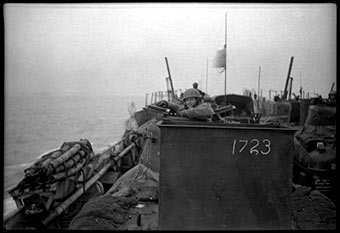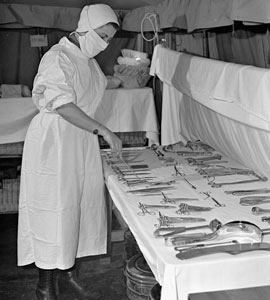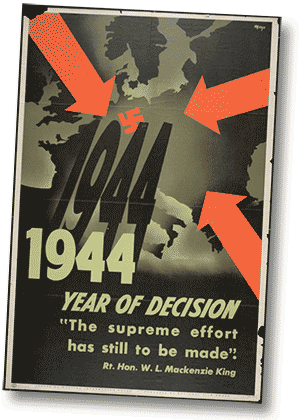5th of June 1944
Anticipation & Delay
The 5th of June, 1944. Not the kind of day the Allied commanders had anticipated. The war was almost five years old. Yet instead of launching the most massive and logistically improbable military operation in history, the soldiers of the Allied Forces — including the tens of thousands of Canadians in the marshalling areas — were idle, waiting for weather, waiting for word.

Lt. Ian McLean of the Sherbrooke Fusiliers in a Cdn Ram tank aboard LCT 1723, training in England for the invasion of Nazi Europe in March 1944. Within three months the SFR would be landing on Juno Beach in new Sherman tanks.
(Photographer: Jim Jones; Maple Leaf Up collection)
The men of the Sherbrooke Fusilier armoured regiment had boarded their many Landing Craft Tank (LCT) a couple days ago. They had driven their Sherman tanks on and off the same ships many times over the last few months, but Capt. Sydney Radley-Walters had a strong feeling this was the real thing. Now, afloat off the Isle of Wight, the men of the SFR slept, read novels, wrote letters home, played cards, and waited.
An hour after they'd loaded onto their Landing Craft Infantry (LCI) yesterday morning on the Southampton Hards, Sgt Stan Dudka and his rifle company of the North Nova Scotia Highlanders were told about the delay. His men put their kit and weapons in the bunks below deck and came back outside to wait and wonder. They'd trained so long, they were anxious to get into action. And they'd been given the distinct honour in 3rd Division of pushing through the first wave beachhead regiments and leading the Canadian attack on D-Day.

The nurses of the Canadian General Hospital in Bramshot, England had been told to clear the wards and make ready for an influx of traffic. Nursing Sister Jane Drean was here when the casualties of Dieppe had shocked these corridors two years earlier. She knew what to expect, but said nothing to the new nurses as they lingered by their radio.
In Hamilton Ontario, newlywed Patricia Boyd mulled over recent letters from her husband, tank commander Nairn Boyd, who had been training in England. Intuitively, from his cautious words, she knew invasion was imminent. Powerless to do anything but pray, she went to work as usual, and waited for word.
In Normandy, German soldiers of the 716th Division kept vigil over the waterfront between St. Aubin and Courseulles as they had for many months, killing little but time. For the French townspeople, sharing their villages with the soldiers of the Wehrmacht the last four years, the waterfront was forbidden. Radios were as forbidden as the waterfront, so villagers traded rumours and nervously waited for liberation. Secretly, resistance agents among the townsfolk manned their hidden wireless radios, waiting to hear specific coded messages — signifying invasion — on the BBC.
Infantryman D’Arcy Bryson of Toronto also waited. But he was waiting in Stalag 8B in Germany, a prisoner-of-war. Bryson was a casualty of the Dieppe debacle. By 6 June 1944 — another meaningless day in captivity — his wait had been 21 months, 2 weeks, and four days. His years of combat and assault training in Canada and the UK hardly seemed worth the less-than four hours his war actually lasted. He wondered about the next soldiers who would embark on the shores of Normandy. How long would their war last? And when would they land..?

Lt. Fred Moar and his platoon of thirty from the North Shore (New Brunswick) Regiment were supposed to be in France at this very moment, but they, along with the thousand other first wave Canadian soldiers on this Landing Ship Infantry (LSI), were still moored in the English Channel, speculating. A violent storm had made it impossible to launch their tiny platoon-size Landing Craft Assault (LCA). They had prepared endlessly and poured over maps and models — real landmarks with phony names. Now, Moar's 'A' Company commander Major McNaughton approached with determination and a sand bag full of maps and said, "It's on." Only at that moment did they unseal the top secret maps to determine their real invasion target — St-Aubin-sur-mer. In Normandy.
That evening the winds abated a little and near midnight their Landing Ship pulled anchor and sailed towards France.
*****
The story of D-Day & Normandy continues next page. ![]()
If you have any observations, comments, insights, or see any errata, typos please Contact Us.






